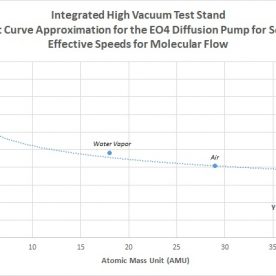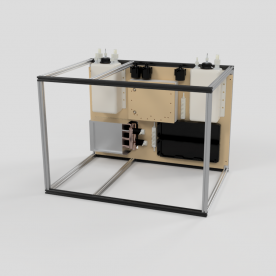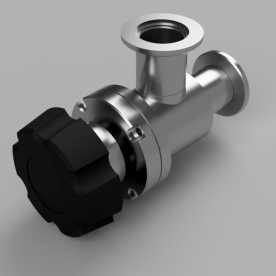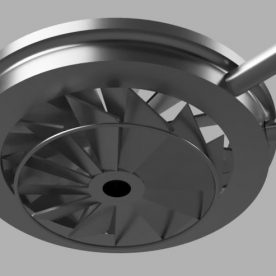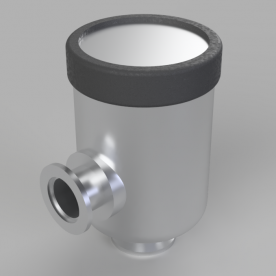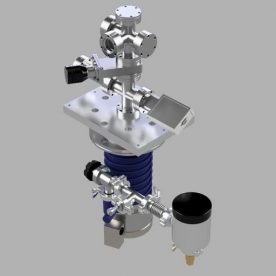MAXIMUM GAS LOADS FOR VARIOUS PROCESS GASES FOR VARIOUS EXPERIMENTS
SYSTEM DESIGN V4
From the previous Chapter 5 calculations, it was shown how to calculate the total gas load for the system V4 design during pumpdown, which consists of water vapor due to outgassing and permeation through the Viton o-rings of the system. Finally, we reach the last gas-dynamics calculations for this vacuum system, which is determining the maximum gas loads for the system across the entire range of operating pressures for all expected processes and gases, now factoring everything that has been calculated prior. This is probably the most important numbers to generate for this whole system, as it verifies what processes could be supported at various vacuum levels, and if these experiments would be even viable for the current design.
The calculations go back to the simple fundamental equation of S=Q/P. The total gas load can be broken down into the total gas load due to water vapor during pumping added to the total process gas load. Since the total maximum gas load allowable at a given pressure can be calculated for a given effective speed, and the pressure and gas load due to water vapor are already known and calculated, then the total process gas load can be calculated. In addition, the gas load, expressed in Torr-L/s, can be converted to commonly used sccm for ease of comparison of flow rates for standard systems, such as standard fusors or electric space propulsion.
For these calculations, the maximum gas loads are calculated from the operating pressures of 10^-2 Torr all the way down to 10^-8 Torr, for air, argon, and deuterium. Water vapor is not needed since that was already calculated prior for the pumpdown gas loads. Notice that air is still included in these calculations – while air will not be actively admitted into the system during runs, the calculations are still important to have, as the calculations for air provide a basis to determine the leak rate of the system at a given vacuum level, accounting for the pumpdown water vapor load, should a leak develop in the system when pumping down and conditioning it. This wide range of pressures and molecular weight gases will allow also allow to establish the upper and lower bounds of what to expect for all other gases with molecular weights in between deuterium, which is incredibly light, and argon, which will most likely be the heaviest gas that will be run in the system. The PDFs for the calculations are included below:
Ultimate Process Gas Load Calculations AIR – Design V4
Ultimate Process Gas Load Calculations ARGON – Design V4
Ultimate Process Gas Load Calculations DEUTERIUM – Design V4
Unlike previous chapters in this walkthrough, the major calculated results will not be summarized below. Everything is presented in tables in the PDFs for reference. The numbers that are red in the tables represent gas flows that are not attainable at a given pressure – in other words, it will not be possible to operate the gas at any flow rate at that pressure. All other numbers in the tables are black, which represents all possible operating conditions. For each of the three gases, all possible flow rates are calculated for the effective pressure range in both the molecular flow regions as well as the transitional flow regions. Therefore both low and high vacuum systems are covered, for all processes that are anticipated to run in the future. Each scenario is also further broken down and calculated for the three pumping conditions introduced in the previous section as well: unbaked and pumped for 1 hour, unbaked and pumped for greater than 24 hours, and baked and pumped for greater than 24 hours. This will provide a benchmark to compare how the system should behave between various stages of running and conditioning.
This concludes the calculations for finding the ultimate allowable process gas loads for this system. These numbers are one of the major end goals to this entire series of calculations, since ultimately they are needed to determine how much gas the system could handle at various vacuum levels, for various gases, and to see how this would change based on the operating criteria for a variety of parameters needed to cover the wide range of planned future experiments. It also allows to gauge how to expect the system to operate, and if certain gas loads and vacuum levels are even viable and achievable given this design. Although the current system cannot support process gases at the upper end of the high vacuum region, it can support gas flows at least from low vacuum to processes operating in the 10^-5 to 10^-6 Torr range, which fits with prior calculations that show that the current system can only achieve an ultimate vacuum in the mid-10^-7 Torr range with just the water vapor gas loads due to outgassing and permeation. Further modifications of the system can be implemented as discussed prior to reduce water vapor loads which allow for higher process gas loads. Additional high and ultra-high vacuum pumps can also be employed, such as ion pumps and titanium sublimation pumps, to supplement pumping in the upper high vacuum regime.

